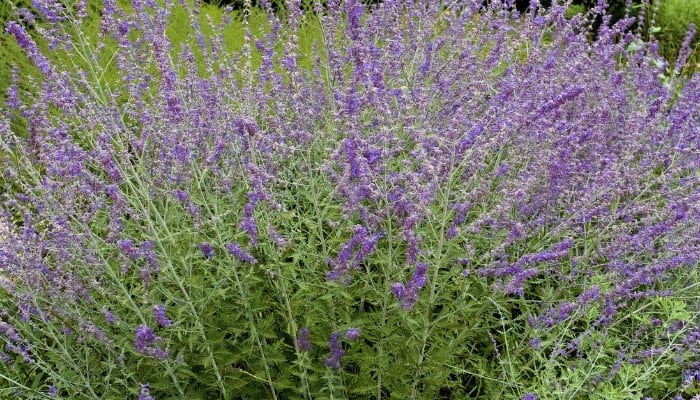Russian sage is renowned for its stunning lavender blooms that sit atop shiny, white stems, making it an ideal centerpiece for any summer garden.
This hardy shrub is drought resistant and thrives in areas that receive full sun. It prefers moist, well-drained soil with a pH of 7.0-9.0.
In addition, it has a fast growth rate and does best when planted in late spring to early summer.
Gardeners love Russian sage as it provides blooms and stunning foliage throughout the growing season, making it one of the best plants to have in your flower garden!
The following 15 plants will compliment Russian sage in a variety of ways.
When deciding which to plant alongside your sage, consider your favorite color combinations and which leaf shapes and textures would most benefit your existing garden space.
1. Daylilies
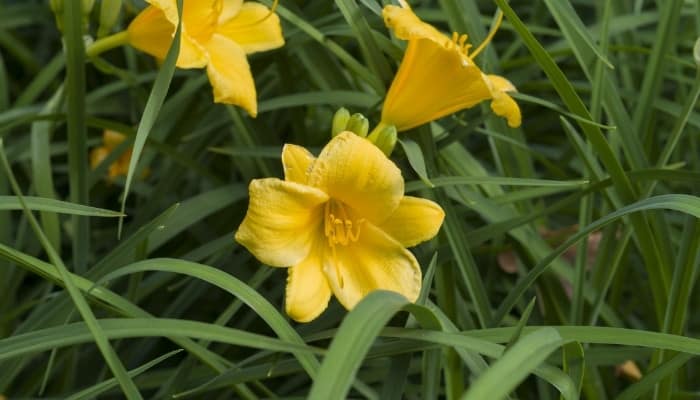
The trumpet-like blooms of the daylily last for a single day but are quickly replaced by new flowers throughout the summer into the fall.
There are thousands of varieties to choose from, ranging in color from the typical yellow daylily to red, purple, and orange. They enjoy full sun and need well-draining acid soil to thrive.
- Botanical name: Hemerocallis spp.
- Average size: Height 8 inches – 5 feet, width 2-4 feet
- Colors available: Cream, red, orange, purple, pink
- Popular varieties: Stoke Poges, Whichford, Pink Damask
2. Black-Eyed Susan
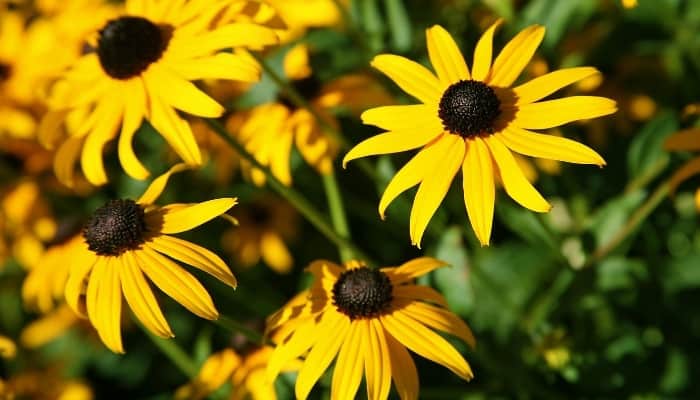
Black-eyed Susans produce beautiful blooms with a yellow to orange hue complimented by brown centers.
They require moist, well-draining soil and thrive in the full sun like their Russian sage companions. They contrast nicely with the purple flowers of the Russian sage.
- Botanical name: Rudbeckia spp.
- Average size: Height 2-3 feet, width 1-2 feet
- Colors available: Orange, yellow
- Popular varieties: Indian Summer, Prairie Sun
3. Yarrow
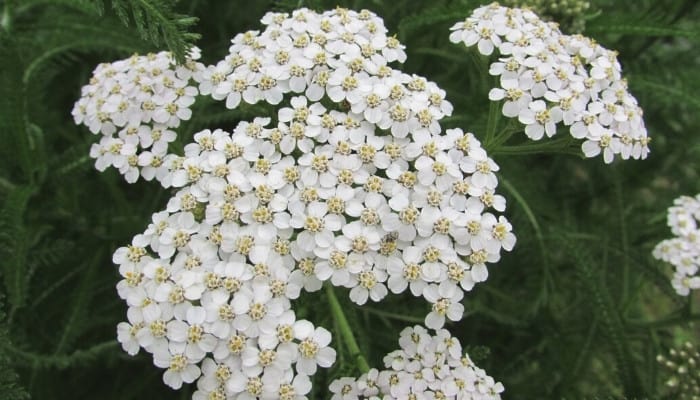
Long woody stems support the daisy-like flowers of the yarrow plant. The yarrow plant needs full sun and rich, well-draining soil to thrive.
This drought-tolerant plant can improve the health of nearby plants and protect those susceptible to disease.
Excellent as a companion plant to many vegetables and flowers, the yarrow plant is the perfect companion for Russian sage.
- Botanical name: Achillea millefolium
- Average size: Height 2-3 feet, width 2-3 feet
- Colors available: White, pink, red, yellow
- Popular varieties: Apple blossom, Cerise Queen
4. Sweet William
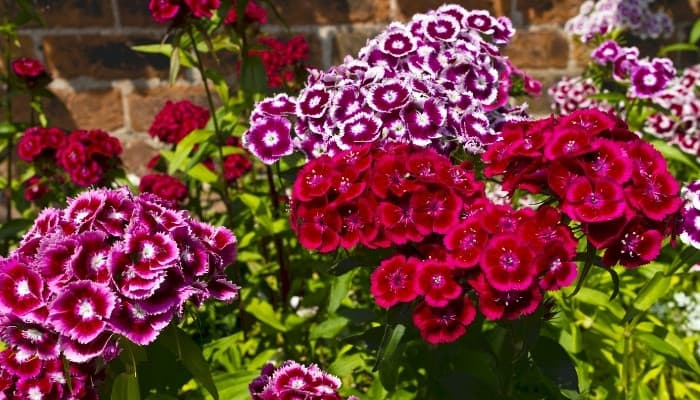
The sweet feather-like flowers of the Sweet William provide lovely splashes of color and scent in the summer garden.
Due to its similar growth requirements, it is the perfect companion plant for Russian sage. It loves full sun but can thrive in partial shade and prefers moist soil that is not boggy.
- Botanical name: Dianthus barbatus
- Average size: Height 1-2 feet, width 0.5-1 foot
- Colors available: Bicolor, white, pink, red, purple
- Popular varieties: Pinnochio, Heart Attack, Wee Willie
5. Coreopsis

The cheerful yellow daisy-type flowers of the coreopsis are highly attractive to butterflies and bees.
Russian sage is equally appealing to these pollinators, and when its purple blooms are paired with coreopsis, it creates a profusion of summer color.
Coreopsis enjoys full sun to partial shade and fertile, well-drained soil.
- Botanical name: Coreopsis verticillata
- Average size: Height 24 inches, width 20 inches
- Colors available: Yellow, orange, pink, red
- Popular varieties: Tickseed, Rising Sun, Lanceleaf
6. Phlox
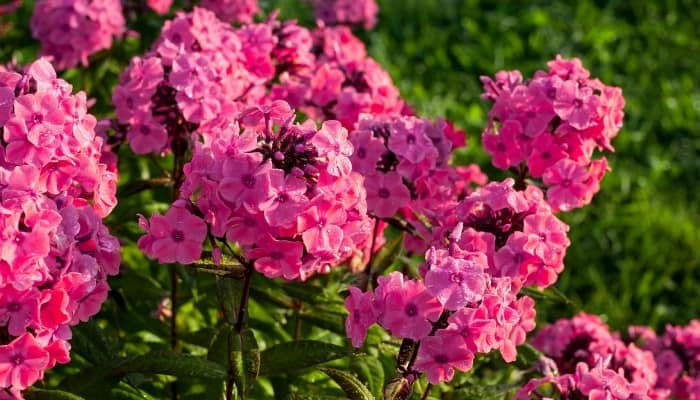
With its dome-shaped flowers on top of sentry-style upright stems, phlox accentuates the garden border with military precision and gorgeous color.
It blooms from spring to late summer in various colors and shades, complementing the purple and silvery hues of Russian sage.
In addition, it prefers free-draining soil and full to partial shade.
- Botanical name: Phlox spp.
- Average size: Height 6 inches – 5 feet (depends on variety)
- Colors available: White, pink, blue, red, yellow, magenta
- Popular varieties: Starfire Phlox, David Phlox
7. Red Salvia
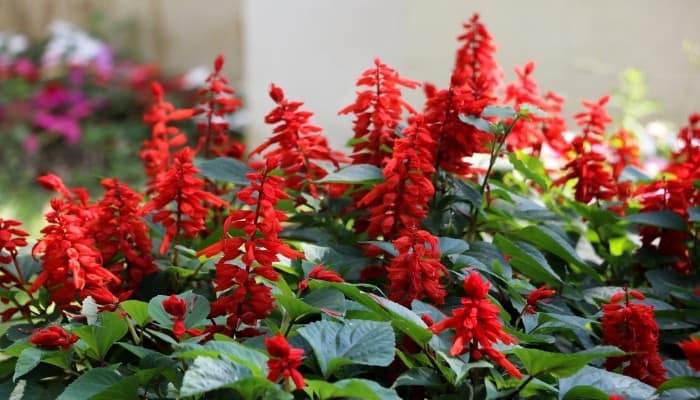
With similar growth habits to that of Russian sage, red salvia is an excellent companion plant. It prefers six to eight hours of full sun each day and moist but free-draining soil conditions.
The leaves of the red salvia give off a scent that discourages deer and rabbits from munching on its foliage. Thus when grown alongside Russian Sage, it protects this plant from would-be pests!
- Botanical name: Salvia splendens
- Average size: Height 1-2 feet, width 9-18 inches
- Colors available: Red
- Popular varieties: Salsa Scarlet Bicolor, Ablazin Purple
8. Sedum
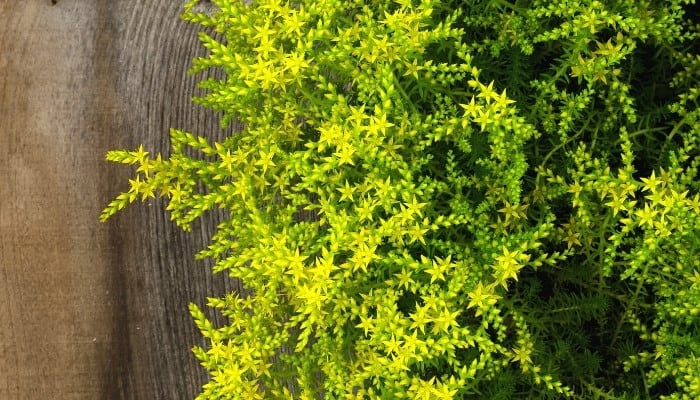
This succulent is excellent when grown as a ground cover alongside Russian sage. This hardy plant thrives in dry conditions and enjoys full sun positions.
Its tiny yellow flowers bloom in the fall and are the perfect contrast to Russian sage, providing lovely color and body to the garden.
- Botanical name: Sedum spp.
- Average size: Height 18 inches, width 18 inches
- Colors available: Copper, yellow, green, purple
- Popular varieties: Sedum adolphi, Sedum acre
9. Red Hot Poker
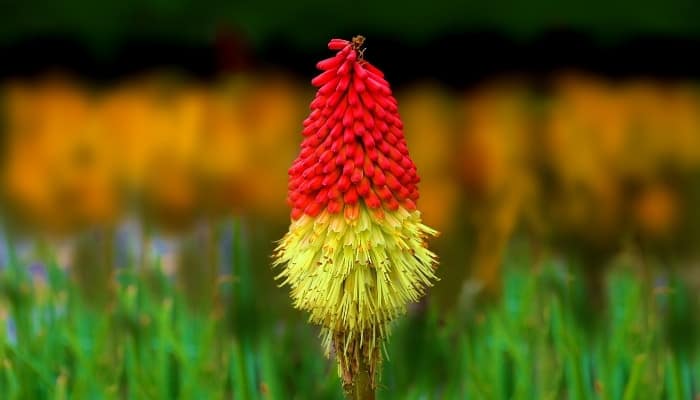
The firey bottle-brush-type blooms of the red hot poker are a gorgeous addition to any summer garden.
These hardy perennials have a fantastic exotic look and flower throughout the growing season.
They do well in the same sun-filled growing conditions as Russian sage and provide masses of interest and color in the summer garden.
- Botanical name: Kniphofia
- Average size: Height 2-4 feet, width 1-3 feet
- Colors available: Red, orange, lime-green
- Popular varieties: Pineapple Popsicle, Ice Queen, Lady Luck
10. Purple Coneflower
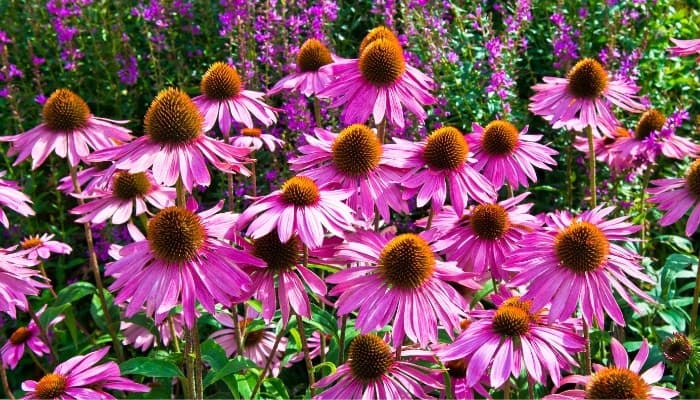
The purple coneflower is hardy and produces purple blooms with a distinct dome-shaped center. It is a magnet for bees and other pollinators and is known for its self-seeding habits.
It enjoys well-drained soil with a neutral to acidic pH, similar to Russian sage.
In addition, it blooms throughout the summer and, when planted alongside Russian sage, provides extra color and texture.
- Botanical name: Echinacea purpurea
- Average size: Height 2-5 feet, width 1-2 feet
- Colors available: Pink, purple, yellow, green
- Popular varieties: Flame Thrower, Greenline, Daydream
11. Milkweed
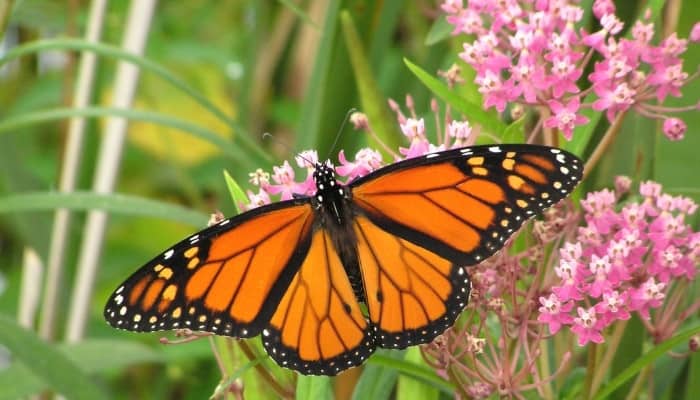
Milkweed is an excellent addition to any summer butterfly garden.
Producing the milky substance monarch butterflies feed on, its stunning sprays of flowers are often pinkish purple but can also be white, red, or beige.
It provides a haven for these delicate pollinators when paired with Russian sage. The plant requires full sun, average well-draining soil, and very little water except in dry conditions.
- Botanical name: Asclepias spp.
- Average size: Height 2-4 feet
- Colors available: Pink, purple, orange, red, yellow, white
- Popular varieties: Showy Milkweed, Whorled Milkweed
12. Hebe
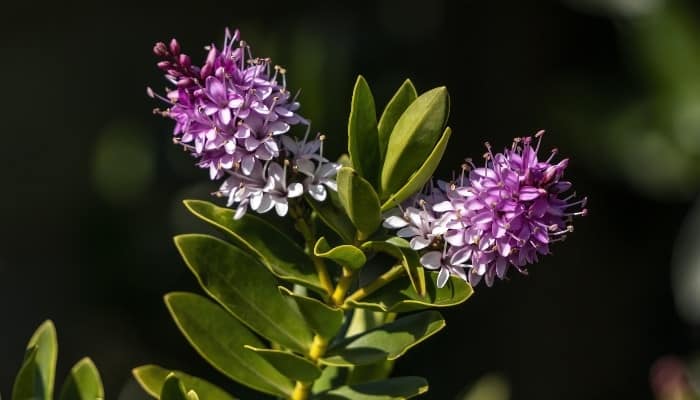
The ornamental but evergreen foliage of the hebe make it an attractive plant to have in the garden all year round.
Its small spikey flowers come in a range of flowers ranging from purple to pink and white. This hardy plant enjoys a warm sunny position in the garden with free-draining soil.
- Botanical name: Hebe spp.
- Average size: Height 3 feet – 6 feet (depending on variety)
- Colors available: Purple, white, pink
- Popular varieties: Golden Pixie, Rosie, Red Edge
13. Petunia
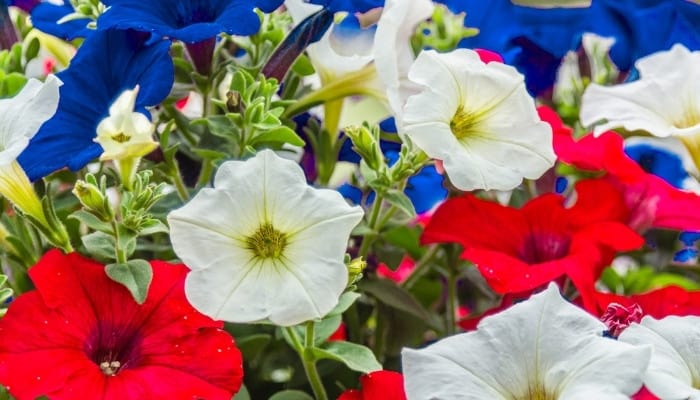
The petunia, with its vibrant array of colors and shapes, is an excellent border plant. It thrives in rich, fertile soil with access to full sun and only requires watering when the weather is dry.
Its similar growing conditions and long flowering period (summer-fall) make it an excellent companion plant choice for Russian sage.
- Botanical name: Petunia spp.
- Average size: Height 18 inches, width 3 inches
- Colors available: Multicolored, blue, purple, white, pink, red
- Popular varieties: Tumbelina, Crazytunia, Double Wave series
14. Goldenrod
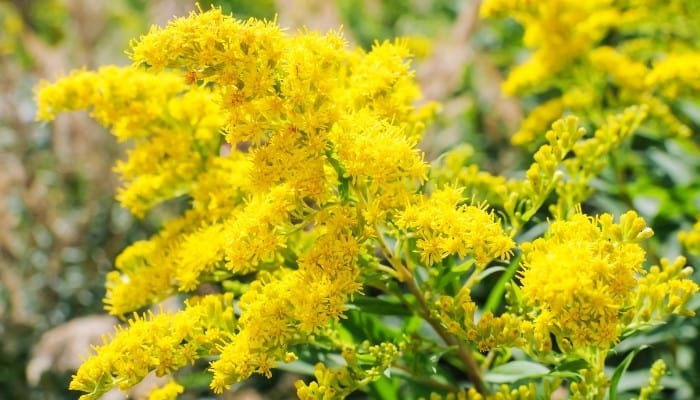
Goldenrod thrives in sandy soil but will tolerate other well-drained soils. It prefers a full sun position in the garden and will self-seed.
In addition, it gets all of its water from rainfall and does not require frequent watering. Related to the daisy family, its tiny yellow flowers contrast beautifully with Russian sage.
- Botanical name: Solidago spp.
- Average size: Height 1.5-5 feet
- Colors available: Yellow, white
- Popular varieties: White Goldenrod, Zigzag Goldenrod
15. Lilies

The thick waxy trumpet flowers of the lily create a gorgeous and fragrant display throughout the summer.
Position in full sun with at least six to eight hours of bright light, and ensure the soil drains well to avoid botrytis fungus. Their similar growth requirements and stunning blooms make them a fantastic plant companion for Russian sage.
- Botanical name: Lilium spp.
- Average size: 1-4 feet tall (Depending on variety)
- Colors available: White, pink, orange, red, yellow
- Popular varieties: Arabian Knight, Anastasia, African Queen
Conclusion
Russian sage is a definite must-have in every summer garden.
Not only is it easy to grow and maintain, but its stunning foliage and flowers provide a picturesque backdrop for many companion plants.
If you want to create a butterfly haven filled with gorgeous scents, textures, and colors, use the above list to select the perfect combination of companion plants!

